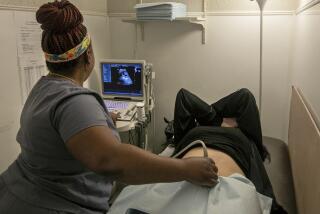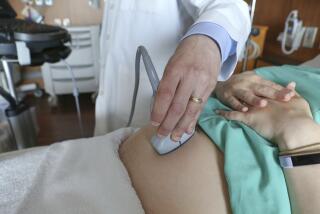Newer Technique for Detection of Birth Defects Called Safe
- Share via
A recently developed technique for early prenatal detection of birth defects is generally “safe and effective,” but is slightly riskier and more prone to failure than amniocentesis, a more widely used technique usually performed later in pregnancy, according to a new study being published today.
The federally sponsored study of about 3,000 women aged 33 years or more found that the increased risk of fetal loss associated with the newer technique, chorionic villus sampling, was 0.8% higher than that associated with amniocentesis. An accurate diagnosis of fetal chromosomal abnormalities such as Down’s syndrome was obtained 97.8% of the time, compared to 99.4% of the time with amniocentesis.
Chorionic villus sampling, or CVS, is “here to stay” but “it will not replace amniocentesis,” said Dr. Lawrence D. Platt of County-USC Medical Center, an expert practitioner of the two techniques who was not involved in the new study.
Chorionic villus sampling is performed during the third month of pregnancy. The tissue for laboratory analysis is obtained from the placenta, the connection between the fetus and the mother, which contains cells that are almost always genetically identical to those of the fetus.
Amniocentesis is usually performed between the 15th and 20th weeks of pregnancy, although some obstetricians are doing the procedure earlier. In this technique, fetal cells and fetal proteins from the amniotic fluid, the liquid that surrounds the fetus, are analyzed.
Platt said chorionic villus sampling “clearly carries the advantages of earlier prenatal diagnosis,” such as reduced patient anxiety and decreased risk to the mother when a birth defect is detected and an abortion carried out.
But he cautioned that chorionic villus sampling also suffered from some of the “inherent limitations” of earlier diagnosis, such as a small increased risk of miscarriages, an increased number of uncertain diagnoses that require further testing and an inability to detect problems that do not manifest themselves until later in pregnancy.
Another drawback is the inability of chorionic villus sampling to detect neural tube birth defects, such as anencephaly and spina bifida. In addition, some parents may elect to terminate pregnancies for non-medical reasons, such as sex selection. Such terminations are rare when the sex of the baby is not learned until later in pregnancy.
There were 25 elective abortions of “chromosomally normal” fetuses in the chorionic villus group, including about 15 for sex selection, compared to two such elective abortions in the amniocentesis group, according to the study.
Many within and outside the medical community object strongly to parents aborting a pregnancy because a fetus is not of the desired sex. Some medical centers have policies against performing prenatal diagnostic techniques for sex selection.
Results similar to those in the new U.S. study were found in a Canadian study of 2,787 women that was published in the Lancet, a British medical journal, in January.
The Canadian study had the advantage of randomly comparing the two procedures, while the American study did not; according to the new report, the primarily well-educated private patients who were studied at UC San Francisco and six other major medical centers resisted a “vigorous effort” to randomly assign them. Instead, they were given a choice between the techniques.
Platt and another expert in maternal-fetal medicine said the data from both studies underscored the need for women to seek medical care early in pregnancy and to discuss with their physicians the pros and cons of the increasingly complicated array of prenatal diagnostic tests.
They also predicted that publication of the study would accelerate a trend toward wider availability of chorionic villus sampling.
Chorionic villus sampling “is a viable alternative to amniocentesis in the hands of experienced people,” said Dr. John Williams III, the medical director of the Prenatal Diagnostic Center of Southern California, a private facility in Beverly Hills. Williams, an assistant professor of obstetrics and gynecology at UCLA, said he performs 15 to 20 procedures a week at his center, which along with UC San Francisco is one of the busiest CVS facilities on the West Coast.
L.A. Performance Rate
Over the last two years, about 1,500 of these procedures have been performed in Los Angeles, compared to more than 22,000 amniocenteses, Platt said. An estimated 50,000 to 60,000 of the procedures have been performed worldwide, according to Williams.
Some insurers, such as Kaiser-Permanente of Southern California and Blue Cross of California have covered chorionic villus sampling since late last year. Others, such as Blue Shield of California and Medi-Cal, the government-supported insurance program for the poor, do not cover the procedure because they consider it experimental.
In addition, physicians offering the procedure must receive specific approval from the U.S. Food and Drug Administration because the catheters, or thin sterile tubes, through which the sampling is performed are considered experimental and none is approved for marketing. About 30 physicians nationwide are estimated to have such authorization.
When asked about the status of the catheters, a knowledgeable FDA official said that they are likely to remain under investigation for some time. To date none of the companies that manufacture them have requested marketing approval and submitted the necessary data for review, the official said.
Chorionic villus sampling was developed in the early 1980s. During the procedure, the catheter is inserted into the uterus through the vagina under the guidance of an ultrasound machine. A small amount of placental tissue is then removed through the tube. The procedure can also be performed by inserting a needle into the uterus through the abdomen.
Preliminary results of the sampling are available within a day and final results--which require culturing cells in a laboratory--within one to two weeks. The total cost in Los Angeles is about $1,300 to $1,400, Platt said.
Level of Discomfort
During amniocentesis, a needle is inserted into the amniotic fluid through the abdomen, also under ultrasound guidance. Because the fetal cells must be grown extensively in a laboratory, complete test results are usually not available for several weeks. The total cost in Los Angeles ranges from $800 to $1,100, Platt said.
Both procedures take 10 to 30 minutes to perform. According to Platt, the level of patient discomfort is similar, although he said the majority of patients seem to find chorionic villus sampling less painful.
Both techniques are most frequently used to screen for Down’s syndrome and other chromosomal abnormalities, which are most common in mothers aged 35 or older. As part of the chromosome analysis, the sex of the baby can be determined as well. The techniques can also be used to screen for inherited genetic diseases, such as Tay-Sachs disease, cystic fibrosis, muscular dystrophy and sickle cell anemia.
The new study was sponsored by the National Institute of Child Health and Human Development in Bethesda, Md.
Results in 2,278 women who had chorionic villus sampling were compared to those in 671 women who had amniocentesis.
Rate of Losses
The total rate of pregnancy losses, including spontaneous abortions, termination of abnormal pregnancies, stillbirths and neonatal deaths, was 7.2% in the group that underwent chorionic villus sampling and 5.7% in the group that had amniocentesis. The highest rate of pregnancy loss followed chorionic villus procedures in which multiple attempts to obtain placental tissue were required.
After adjustment for differences in the ages of the mothers and the fetuses--which influence the expected rate of fetal loss--the researchers said the “total loss rate” for women in the chorionic villus group exceeded the rate for the amniocentesis group by 0.8%.
The most common symptoms after the procedures were cramping and spotting; these were more common in the chorionic villus group. None of the pregnant women suffered serious infections, although such infections are known to be a rare complication of chorionic villus sampling.






